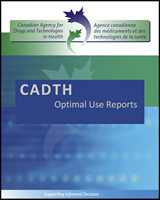Except where otherwise noted, this work is distributed under the terms of a Creative Commons Attribution-NonCommercial- NoDerivatives 4.0 International licence (CC BY-NC-ND), a copy of which is available at http://creativecommons.org/licenses/by-nc-nd/4.0/
NCBI Bookshelf. A service of the National Library of Medicine, National Institutes of Health.
Optimal Use Recommendations for Second- and Third-Line Therapy for Patients With Type 2 Diabetes [Internet]. Ottawa (ON): Canadian Agency for Drugs and Technologies in Health; 2013 Jul. (CADTH Optimal Use Report, No. 3.1D.)

Optimal Use Recommendations for Second- and Third-Line Therapy for Patients With Type 2 Diabetes [Internet].
Show detailsTo facilitate comparisons of antihyperglycemic drugs, the Committee proposed that the following issues be addressed through well-designed, adequately powered studies:
7.1. Second-Line and Third-Line Pharmacotherapy
7.1.1. Efficacy
- Direct or indirect comparisons assessing the relative efficacy of different antihyperglycemic drugs for the prevention of macrovascular and microvascular diabetes-related complications.
- Due to the relatively short duration of the included trials, it was impossible to accurately determine whether there were differences in the durability of antihyperglycemic effects across the various drug classes.
7.1.2. Harms
- The long-term safety profile of newer classes of antihyperglycemic drugs (e.g., DPP-4 inhibitors and GLP-1 analogues).
- The incidence of severe hypoglycemia within each drug class when combined with metformin and a sulfonylurea.
- The impact of changes in body weight (both weight loss and weight gain) and hypoglycemia on the quality of life of patients with type 2 diabetes. While a number of studies have reported disutilities for hypoglycemia, uncertainty remains in this area due to methodological limitations and considerable variability in the reported estimates.
- Patient characteristics (e.g., age) that may increase the risk of hypoglycemia.
7.2. Combination Use of Incretin Drugs and Insulin
- Additional direct comparisons between the addition of an incretin drug to an existing insulin regimen and intensification of insulin treatment for patients inadequately controlled on their existing insulin regimen.
- A cost-effectiveness analysis based on robust clinical data comparing the addition of an incretin drug with an existing insulin regimen and intensification of insulin treatment for patients inadequately controlled on their existing insulin regimen.
- RESEARCH GAPS - Optimal Use Recommendations for Second- and Third-Line Therapy f...RESEARCH GAPS - Optimal Use Recommendations for Second- and Third-Line Therapy for Patients With Type 2 Diabetes
- transcription factor IIIB 90 kDa subunit isoform X13 [Homo sapiens]transcription factor IIIB 90 kDa subunit isoform X13 [Homo sapiens]gi|2462539957|ref|XP_054231895.1|Protein
- Taxonomy Links for Protein (Select 1608036679) (1)Taxonomy
- Homo sapiens chromosome 15, GRCh38.p14 Primary AssemblyHomo sapiens chromosome 15, GRCh38.p14 Primary Assemblygi|568815583|gnl|ASM:GCF_000001305| f|NC_000015.10||gpp|GPC_000001307.1||gnl|NCBI_GENOMES|15Nucleotide
- RNA-seq of sexed adult tissues/body parts from eight Drosophila speciesRNA-seq of sexed adult tissues/body parts from eight Drosophila speciesRNA-seq of sexed adult tissues/body parts from eight Drosophila speciesBioProject
Your browsing activity is empty.
Activity recording is turned off.
See more...